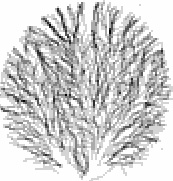|
|
Dynamics of Steady-State Drainage
Basins: An Experimental Approach
|
|
In recent years geomorphology has
experienced a rejuvenation of interest in landscape scale erosion. Landscape
evolution modeling has become almost routine, and new models continue to be
developed that incorporate greater complexity and feedback between climate,
tectonics, and erosion. Our (Les Hasbargen and Chris Paola) approach has been
to take a step back, and compare results from the least complicated models
with results from a similarly simplified physical experiment.
We have built an erosion facility that
allows a miniature landscape to erode through several relief distances at
constant base level fall and rainfall rates. This kind of experiment permits
observation of drainage basin dynamics at steady
forcing, offering a view into the internally generated behavior due
solely to feedback between stream erosion and transport, and hillslope
sediment supply. The landscapes in our basin develop dendritic 3-5 order
drainage basins. Dominant erosional processes include stream incision and
hillslope failures. We note that knickpoint generation and migration is very
common. While it is quite simple to force knickpoint generation with abrupt
drops in base level, knickpoints form in our experiments under constant base
level fall conditions.
The relative activity of erosive processes
is sensitive to rainfall and base level fall rates. For instance, rapid
uplift (i.e., base level fall) forces larger hillslope failures, and result
in larger oscillations in sediment flux leaving the basin. We have conducted
7 runs in the facility thus far. Below you will find a smattering of visual
data from the experiments. We collected time lapse video, digital still
photographs from stereo locations, and sediment and water flux measurements
at the outlet to the basin. All of the runs begin with an initial flat
surface with very low surface roughness. The drainage basin forms by headward
erosion from the outlet. A rough balance between erosion and uplift (i.e.
'base level fall) is reached shortly after complete dissection of the
surface.
For runs below, u
= uplift rate and r = rainfall rate in mgrams/cm2/s
[L/T]*[M/L3]; r/u (the water-to-rock ratio) is a
dimensionless forcing parameter... A few conclusions from our experimental work...
|
||
Visual
Imagery of Experimental Drainage Basin Evolution
Time lapse video of the ground surface, viewed from above
the basin (files are cinepak format (*.avi), best viewed with Windows Media Player; VideoLAN, an open source media player, works too: http://www.videolan.org/vlc/index.html)
(video info)
Still photo sequences (longer duration between images, but
higher resolution; *.avi files are rendered better
than gif animations, but are bigger files; *.avi
best viewed with Windows Media Player)
|
||
Elevation
Time Series, Derived From Stereophotogrammetry
Raw elevation animations (gif format)
Processed elevation animations (gif format)
Local relative height animations (gif format)
Spatial erosion rates, derived from differencing gridded
elevations (gif format)
Elevation Data as simple text files, as gridded or vector
(x,y,z) data; note the
letter ‘g’ in the file name indicates a group of photos taken during the run
used to generate the elevation data. The links will take you away from the
SUNY Oneonta server to Google Drive. Includes sediment flux, run conditions,
ground control for photos, substrate mix, etc for
each run.
|
||
Spatial
and temporal statistics of
experimental landscapes
|
||
Pretty pictures of the basin from
a lower angle...
|
||
Numerical
models of Eroding Landscapes
I have written into code a couple of the
published landscape evolution models out there (Howard, 1994; Chase, 1991), to
get some sense of the kind of erosional behavior one might expect from them.
See Alan Howard’s excellent page in
landscape erosion modeling. I modified Howard's model to my own
ends...Some of the changes are to the numerical lattice boundaries. I set a
single outlet for eroded material to exit the lattice, and enforced a planform boundary to the lattice similar to my physical
sandbox experiment. I also modified processes operating on the numerical
lattice, such as erosion based on stream curvature, hillslope failure, and
directional diffusion. For more details on erosional processes, see information on the model used to
make these animations. Model animations (time series of gray scale
elevation fields) R2 upstream area + diffusion + periodic uplift
(gif animation 414
kb)(input parameters) R9 upstream area +diffusion (gif animation 475 kb)(input parameters) R12 upstream area +diffusion (gif animation 664
kb)(input parameters) R13 upstream area +slope failure (gif animation 682 kb)(input parameters) R 18 upstream area + stream curvature (gif animation 681 kb)(input parameters) R22 slope failure only (gif animation 376 kb)(input parameters) R27 upstream area + stream curvature
(gif animation 670
kb)(input parameters) R29 upstream area + asymmetric diffusion
(gif animation 662 kb)(input parameters) R30 upstream area + asymmetric diffusion (gif
animation 645 kb and 304 kb-4_color)(input parameters) A few conclusions... ·
While the numerical simulations exhibit
lateral migration of ridges/streams, this behavior dies out as some (for lack
of a better term) optimal network is achieved. All of the simulations I have
run are driven to this stable form (though some of the simulations clearly
were not run long enough...). Stability is achieved shortly after a balance
between erosion and uplift has been established, and usually not more than a
relief's worth of erosion beyond complete dissection of the initial surface
(Howard notes a limit of 3 reliefs to achieve stability). ·
When ridges do migrate, they appear to 'close'
from the upstream to the downstream end. ·
Adding additional terms to the erosion law,
such as for stream curvature, for threshold slope driven slope failures, or
general diffusion, does not lead to self-sustaining migration. Numerical
Model runs last updated June 11, 2001 by Les Hasbargen |
||
page last modified October 11, 2013 by Les
Hasbargen
Email: Leslie.Hasbargen@oneonta.edu
Dept. of Earth & Atmospheric Sciences
State University of New York, College at Oneonta
Les’ web site: http://employees.oneonta.edu/hasbarle/
Les is solely responsible for the content in this web site.
|
||



